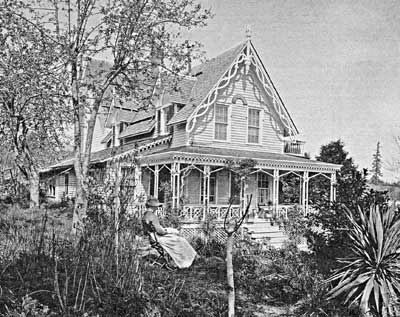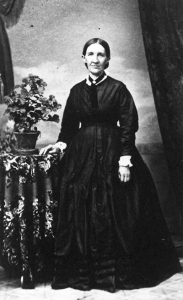Pioneer Profiles – August 2014 – “Photographer, Visionary, Entrepreneur”
In the mid-1800s, the promise of gold and free land lured fortune seekers and settlers to the newly formed Oregon Territory. They were soon followed by merchants who amassed their own wealth selling supplies to the miners and farmers. This on-going series shares the stories of these pioneers and their times.
The past two Pioneer Profiles have partially explored the public persona of Peter Britt, the pioneer Swiss photographer famed for documenting Southern Oregon’s people, activities, and landscapes, and father of the region’s commercial orchard, wine, and ornamental horticulture industries. Britt also served two terms on the Town Council, was one of the largest landholders in Southern Oregon, and was heavily involved in the many local German organizations (coming in September Pioneer Profiles).
But Britt also had a private side. The final installment in this trilogy focuses on Britt’s home and family life.
When Britt arrived in Jacksonville in late 1852 with a two-wheeled cart of photographic equipment, a yoke of oxen, a mule, and five dollars in his pocket, he camped on a brushy hillside, now part of the Britt Festival grounds and the lower Britt Gardens. He subsequently filed a donation land claim, and eventually owned the entire ridge between Jackson Creek and Rich Gulch.
Britt’s initial dug-out log cabin, located by Southern Oregon University archaeologists in 2010, served as combination living quarters and daguerreotype studio. By 1854 Britt already considered it crude and confining. He cleared ground for a new one-story studio and residence which he constructed in front of the old cabin. This small studio remained the core of Britt’s home as numerous additions were made over the years, and its original Classic Revival style was transformed into one of the first Cottage Gothic dwellings in Southern Oregon complete with elaborate “gingerbread” elements.
In early 1861, Britt received a life-altering missive from his brother Kaspar, who had been among the family members immigrating to Illinois in 1845. Back in Switzerland, the two brothers had courted the Grob sisters, Anna and Amalia, daughters of the local schoolmaster. Kaspar had married Anna in Switzerland, and she had accompanied the family to the United States. However, Herr Grob never approved of Peter, ranking an itinerant portrait painter only slightly more respectable than an actor or a gypsy.
Amalia married a distant cousin, Kaspar Grob, and in 1854, they immigrated with their infant son Jacob (Jake) to Wisconsin. A daughter, born there, did not survive. Seven years later, Grob, a carpenter, was taken violently ill and succumbed to a stroke, leaving Amalia and Jake with no income. Kaspar Britt’s letter informed Peter of the circumstances.
Peter wrote to Amalia immediately, sending sufficient money for her to return to her family in Switzerland or to join him in Jacksonville. She chose Oregon and Britt. With her young son Jake, Amalia made the arduous journey down the Mississippi to New Orleans, around Cape Horn to San Francisco, by steamer to Crescent City, and finally by stage to the Applegate stop. Britt met her there, and they were married at the home of Kaspar Kubli, a fellow Swiss immigre.
Britt brought Amalia back to his hillside cottage, and there, a year later, a son, Emil, was born. To commemmorate the event, Britt planted a seedling sequoia he had obtained in Crescent City. Today this Oregon Heritage Tree is 152 years old, stands 205 feet tall, and can be seen at the Jacksonville Woodlands’ Sarah Zigler trailhead that begins in the lower Britt Gardens.
Anticipating a growing family, Britt needed a larger residence. In the fall of 1862, carpenters began work on Britt’s new design—an imposing second story of skylit studio space, reconfiguration of first floor living space, and the addition of a solarium and wine cellar. The entire residence was painted a pumpkin color to contrast with its white gingerbread trim.
The space was soon in use. Two years later a son, Arnold, was added to the family. Arnold lived only three months, but one year later Amalia Dorothea Britt, affectionately known as Mollie, was born.
However, over the next few years, Amalia’s health began to fail. Weak from bearing five children and plagued by a chronic intestnal disorder, Amalia died on September 28, 1871, and Britt lost the love of his life. In the space of ten short years, Britt had gone from carefree bachelor to husband, father, and now widower.
Britt never remarried, so was left to care for three small children. Moreover, in 1875, Britt became the guardian of three boys—Fritz, Henry, and Kap—following the double suicide of their parents, Frederich and Anna Ruch.
The Britts were a close knit family, and Peter seems to have both enjoyed and succeeded in the role of fatherhood. The children later told stories of school (“Barron” J.L. DeBussche’s “Select School” and William Kreuzer’s “German Private School for the boys, St. Mary’s Academy for Mollie); escapades, traveling circuses, picnics, field trips, athletic contests, music lessons and activities, and the money-making projects they undertook.
The Ruch boys all became succesful Southern Oregon businessmen. Kap became postmaster of Ruch, and the settlement bears his name. Jake Grob managed Britt’s vineyards, orchards, and landholdings. Emil joined his father in the photography business, in anticipation of which, Britt added a large two-story addition to the rear of his old gallery home. Both Jake and Emil served on the Town Council, and Emil became a perennial councilman and mayor. Mollie took over the role of housekeeper for the family.
Britt died in 1905. None of his children every married. They continued to live in Peter’s elaborate Gothic creation that reflected both his vision and success until their deaths.
The house was destroyed by fire in 1960 and the grounds have since been designated county and city parks. But as the Southern Oregon Historical Society observed in its popular exhibit, “Peter Britt: The Man Beyond the Camera”:
“More than 150 years after a nearly broke Swiss immigrant arrived in a muddy mining camp, his legacy lives through the pictures he took, his paintings, the gardens he planted, and a vital agricultural heritage he helped foster.”
Pioneer Profiles is a project of Historic Jacksonville, Inc., a non-profit whose mission is helping to preserve Jacksonville’s Historic Landmark District by bringing it to life through programs and activities. Visit us at www.historicjacksonville.org and follow us on Facebook (historicjville) for upcoming events and more Jacksonville history.

